How to properly use Diamond Tools
-
Posted by
 Alexander Schneider
Alexander Schneider

Table of Contents
ToggleUKAM Industrial Superhard Tools manufactures precision diamond tools for a large variety of applications, materials, and industries.
Share this Article with Friend or Colleague


Metal Bonded Diamond Tools are “impregnated” with diamonds. This means that selected diamonds are mixed and sintered with specific metal alloys (such as iron, cobalt, nickel, bronze, and over 200 other components in various combinations). To achieve the best cutting performance possible on any materials such as sapphire, glass, granite, tile and etc.
The metal bond surrounding the diamonds must wear away to continuously keep re-exposing the diamonds for the diamond tool to continue cutting. Diamond is the hardest material known to man kind. When used on tools, diamond grinds away material on micro (nano) level.
Metal Bonded Diamond Tools are “impregnated” with diamonds. This means that selected diamonds are mixed and sintered with specific metal alloys (such as iron, cobalt, nickel, bronze, and over 200 other components in various combinations). To achieve the best cutting performance possible on any materials such as sapphire, glass, granite, tile and etc.
The metal bond surrounding the diamonds must wear away to continuously keep re-exposing the diamonds for the diamond tool to continue cutting. Diamond is the hardest material known to man kind. When used on tools, diamond grinds away material on micro (nano) level.
If the tool becomes overheated, the metal bond does not wear away, instead it “glazes over” the diamond. Hence coating or covering the diamond. The metal bond then becomes the cutting agent rather than the diamond. Generating more heat. The diamond tool will eventually chip the material or break it, due to excessive heat build up in material. Same heat may damage the diamond tool itself, by causing heat cracks in the diamond section.
This has been a frequent problem with most conventional diamond tools. Much of this has been resolved with the introduction of, SMART CUT™ Technology. Advanced technology, that redefines the standard in cutting and drilling. Diamonds are oriented and evenly distributed inside the metal matrix, so that every diamond is better able to participate in the cutting action.
Optimum diamond tool performance can be achieved through the proper use and basic care of your diamond tool, before and during its use. This instruction manual has been written tool help you get the most out of your diamond tool investment.


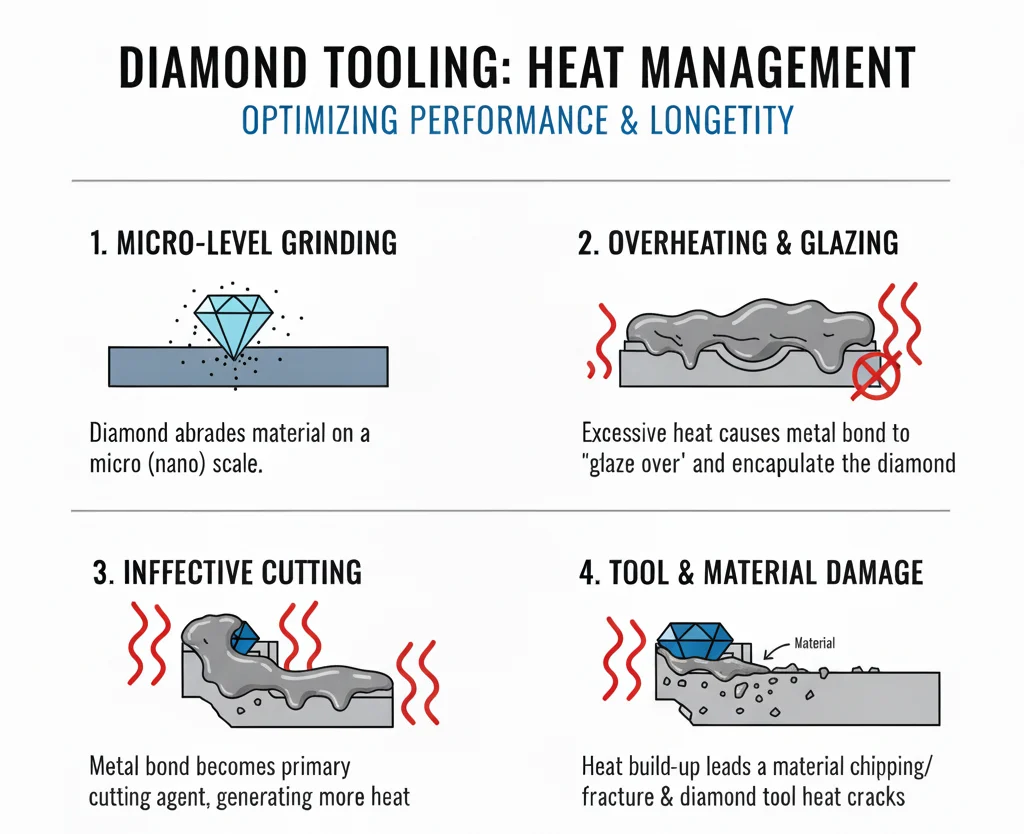
SELECTING THE RIGHT DIAMOND TOOL FOR YOUR APPLICATION

In order to help you select the right diamond tool for your application, our staff may ask you many questions about the material you wish to machine. These questions will specifically focus on:
-
 Material being machined
Material being machined
-
 How you plan to machine it
How you plan to machine it
-
 Equipment you will be using
Equipment you will be using
-
 RPM of that machine
RPM of that machine
-
 Coolants used
Coolants used
-
 Flange size
Flange size
You may wonder why we need to know this information? Each diamond tool is designed specifically for each application, and hence may react differently under different conditions. What worked for one application, may not work for another.
BASIC PROCEDURES YOU SHOULD FOLLOW WHEN USING DIAMOND TOOLS
Although we realize than in many circumstances, there are a variety of factors that may prevent you from following all the suggested procedures. And not all jobs or operations can be done in a controlled environment such as a shop or lab. Nor all equipment on the market can be adjusted to suitably accommodate a diamond tool needs.
Frequently, you will find the best performance will be achieved by following these guidelines as closely as possible.

Use the right diamond tool for your application
Provide as much information possible about your application and material being machined. We can help you better define your needs, so you can obtain the right tool for the job. Saving money and time.
Use the right RPM’S
If the RPM on your equipment runs either too fast or too slow, excessive heat will be generated. Hence damaging your diamond tool. Charts provided in this manual will help you identify and select the right RPM’s for your diamond tools. As well as provide suggestions on ways you can achieve it.
Use the right coolant at point of contact
Depending on your application, there is a large variety of coolants you can select. Ranging from plain water, to water soluble coolants, to minerals and oils. Your specific application will be a determining factor in selecting a coolant. Not matter what coolant you decide to use, make sure it is used at the point of contact where material and tool intersect. Find out more: Diamond Tool Coolants
Dressing will keep diamonds thoroughly exposed at all times
Dress your new diamond tools before usage. Make sure to frequently redress your diamond tool while using it. Always use a recommended dressing stick. Find out more: Dressing Sticks
Use the right diamond tool accessories
When cutting, use the right size flanges or wheel stiffener sets with all thin diamond blades to firmly hold it in place. This will help prevent the blade from “walking”. Use Drill Head Assemblies (water swivel adapters,) with core drills to provide coolant (water) through the center of the drill and on to drilling zone.
THE RIGHT RPM’S
One of the most critical factors in successful diamond tool usage is the right RPM’s. If the diamond tool rotates to slow, it drags and creates heat. If it spins to fast, it causes friction and again generates heat. Heat is the worst enemy for a diamond tool. Selecting the right RPM becomes a critical factor of success. Unfortunately, this can also be the most difficult aspect of cutting or drilling to correct. Unless you have a machine with variable speed capability, most machines will only run at 1,725 to 3,450 RPM. Diamond tools frequently require RPM’s from 100 to 23,000. If you use diamond tools on a regular basis, you may want to consider altering your machinery to accommodate variable speed capability.
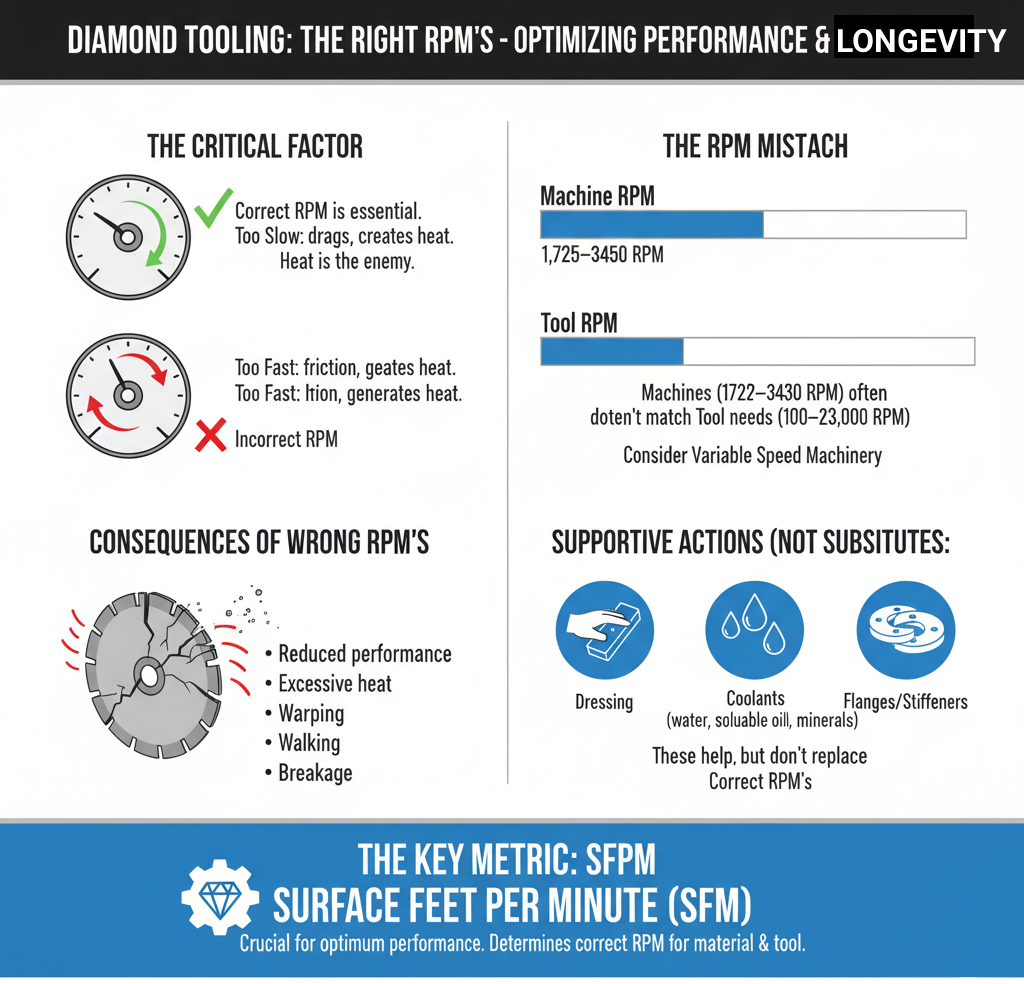
Using diamond tools at incorrect RPM’S will effect their performance. Causing excessive heat generation, warping, walking, and breakage. Frequent dressing, using right coolants, and using right flange sizes or wheel stiffeners can help. But will not completely substitute for correct RPM’s. To determine the correct RPM’s for the optimum performance of your diamond tool, you must know the Surface Feet per Minute (SFPM) required to machine your material. The following “Guide to Operating Speeds for Diamond Tools” calculator includes a broad range of materials and the Surface Feet per Minute (SFPM) required to cut them. Input the SFPM needed, input the size of the blade or drill and calculate the SFPM or RPM you need to use with that tool.


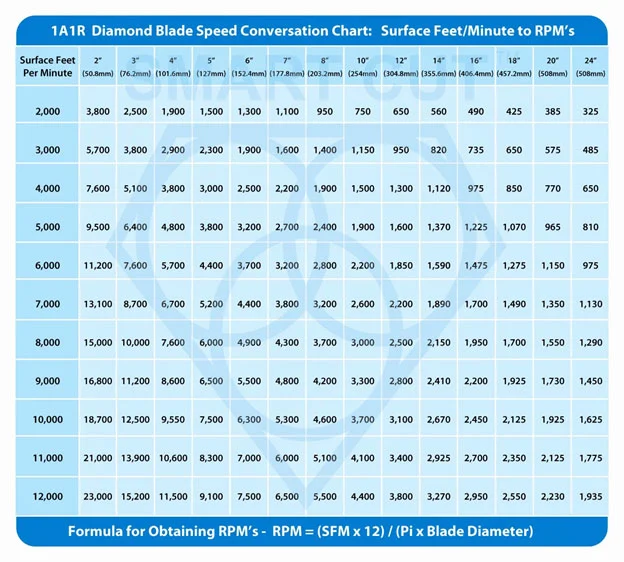


COOLANTS AND DIAMOND TOOLS
All diamond tools require some for of coolant flooded at the point of contact to keep the diamond tool cool. The best option is to have the coolant flooded at the point of contact of a blade or down the center of a drill by using a Drill Head Assembly (water swivel adapter). Water can be used as a coolant for most materials, such as sapphire, granite, and glass. Although water has no “lubricity”, degree a given substance is able to lubricate another substance.
Unlike most diamond tool manufacturers, we recommend that you use water or water soluble coolants for most application.
Oil is not a proper coolant, as most other diamond tool manufacturers would suggest. Water is a true organic coolant, which does not leave the material being machined oily, greasy, or contaminated.
Water does turn to steam at temperatures exceeding 212 degrees Fahrenheit. So, adding a nonsudsing detergent will help water provide more lubricity and serve longer as a coolant. Occasionally, it may be necessary to mover from water to water soluble coolants. Such as when machining harder and more dense materials.
If coolants cannot be used, a resin bond or electroplated (nickel bonded) diamond product may be a solution. It is also important to remember that coolant must be delivered at the point of contact where the diamond tool and material intersect. When a diamond tool is turning at the right RPM’s, momentum will throw the coolant out and away from the point of contact. When the diamond tool begins to rotate, and coolant is not delivered as close as possible to the point of contact, Heat will begin to generate, and the diamond tool will “glaze over” with the bond no longer allowing diamonds to perform the cutting action.


DRESSING DIAMOND TOOLS
Diamond tools must be both trued to and dressed on the machine on which it will be used. This will guarantee two things:
-
 Diamonds will be thoroughly exposed
Diamonds will be thoroughly exposed
-
 Diamond tool will be “true in running (T.I.R.)” on your machine \
Diamond tool will be “true in running (T.I.R.)” on your machine \
Remember that every machine runs differently. And even if the diamond tool is trued at the factory, it can still “run-out” of tolerance when you place it on your machine. Blades must e trued and drills must be indicated in. Truing a tool is the operation of squaring a tool so it runs within your tolerances. This may be done with a hard stone that will knock diamonds out. This operation differs from dressing. It is still necessary to dress the tool after truing as the diamonds will no longer be sticking-up.
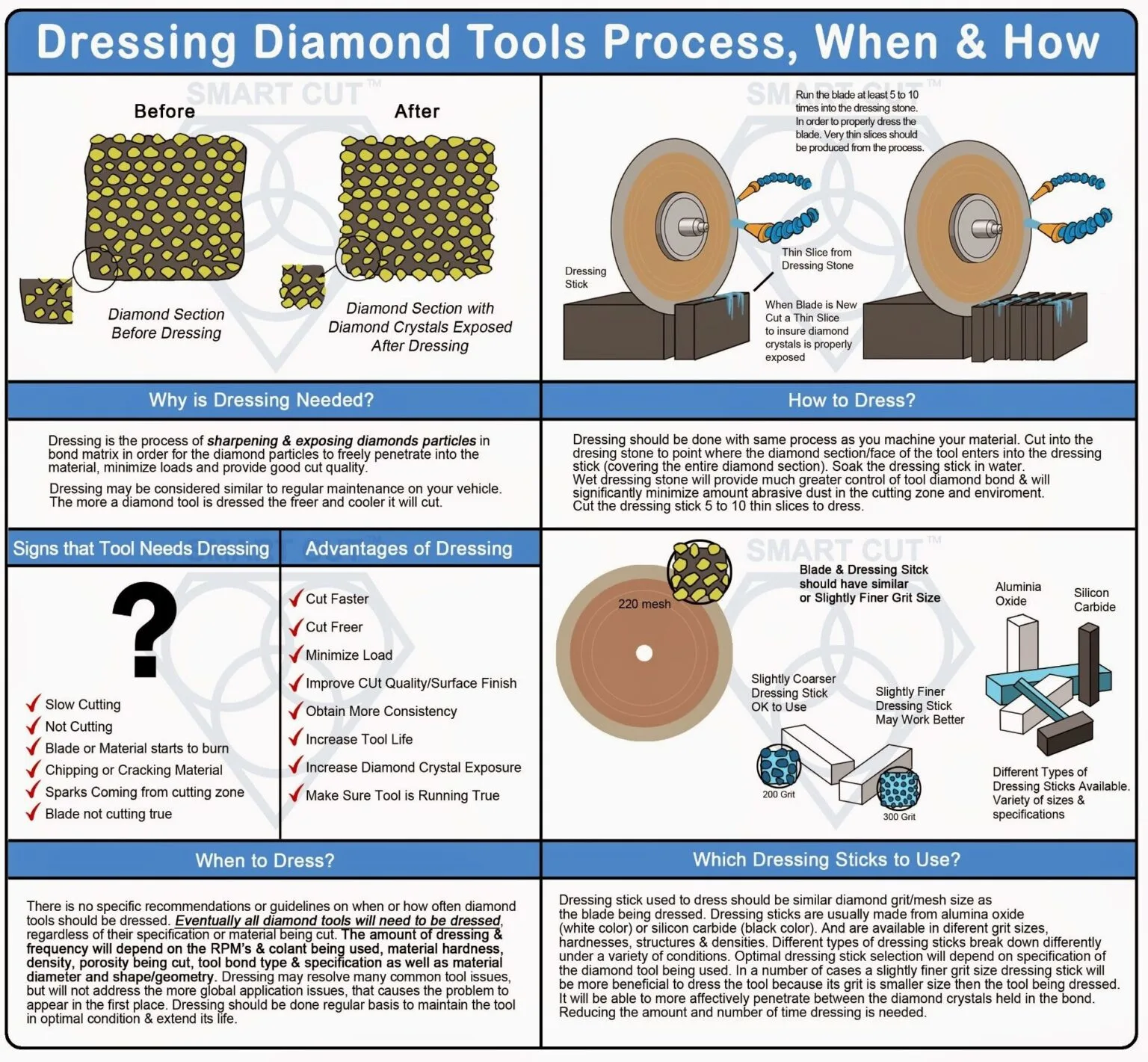
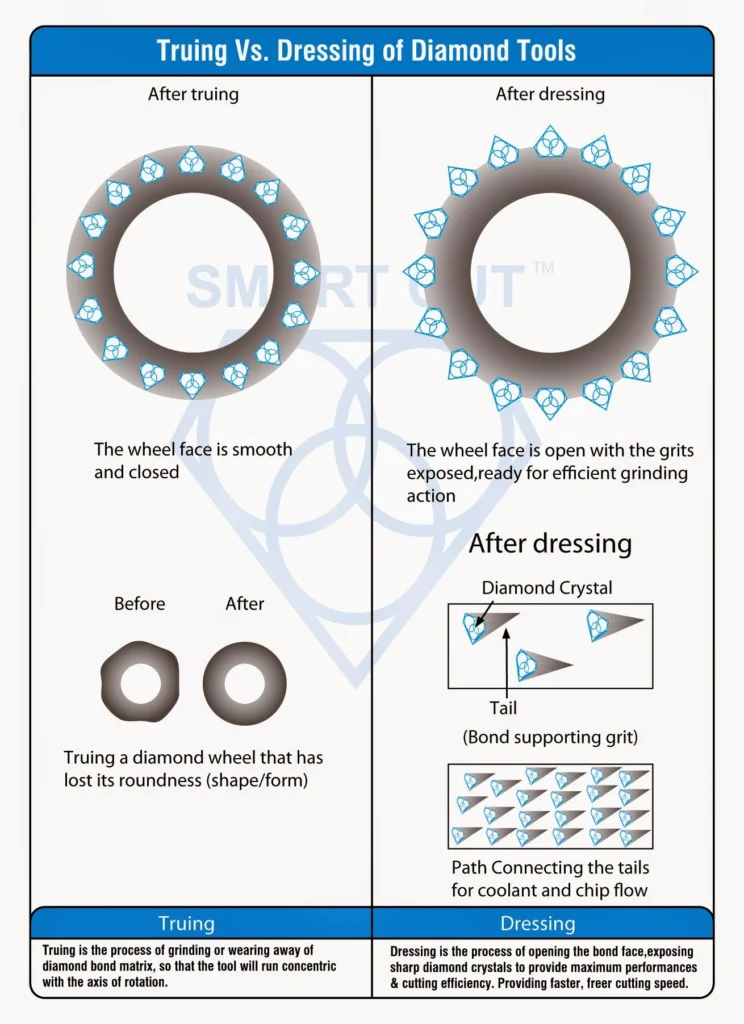
After truing the diamond tool, it is important to dress it to make sure the diamonds are exposed. The diamonds must be sticking up “exposed” from the bond matrix. If this is not accomplished, you will experience difficulty with your new diamond tool. A diamond tool that is thoroughly dressed will have diamond “tails” extending from the back of the diamond. Your diamond tool is now “directional”. This means it should always run in the direction the leading edge of the diamond, away from the tail. So the sharper, leading edge of the diamond can achieve desired cutting action.
When your diamond tool is new, it should be dressed thoroughly by the operator. Never assume because the tool is new, that it does not require this operation. Dressing diamond tools is similar to dressing a knife with a stone. You want your knife as sharp as possible when you begin cutting as you do your diamond tool. In much the same way you make passes across the stone with the knife, you make several cuts into the dressing stick with the diamond tool. Using the correct, soft dressing stick, it is recommended that the tool is passed through the tick five to ten passes to expose the diamonds for optimum cutting performance.
USING THE RIGHT DRESSING STICK FOR THE APPLICATION
If the dressing stick is too hard, it will “knock the diamonds out”.
UKAM Industrial Superhard Tools can provide the proper dressing stick to avoid this problem. The more diamonds are exposed, the better the performance of the diamond tool.
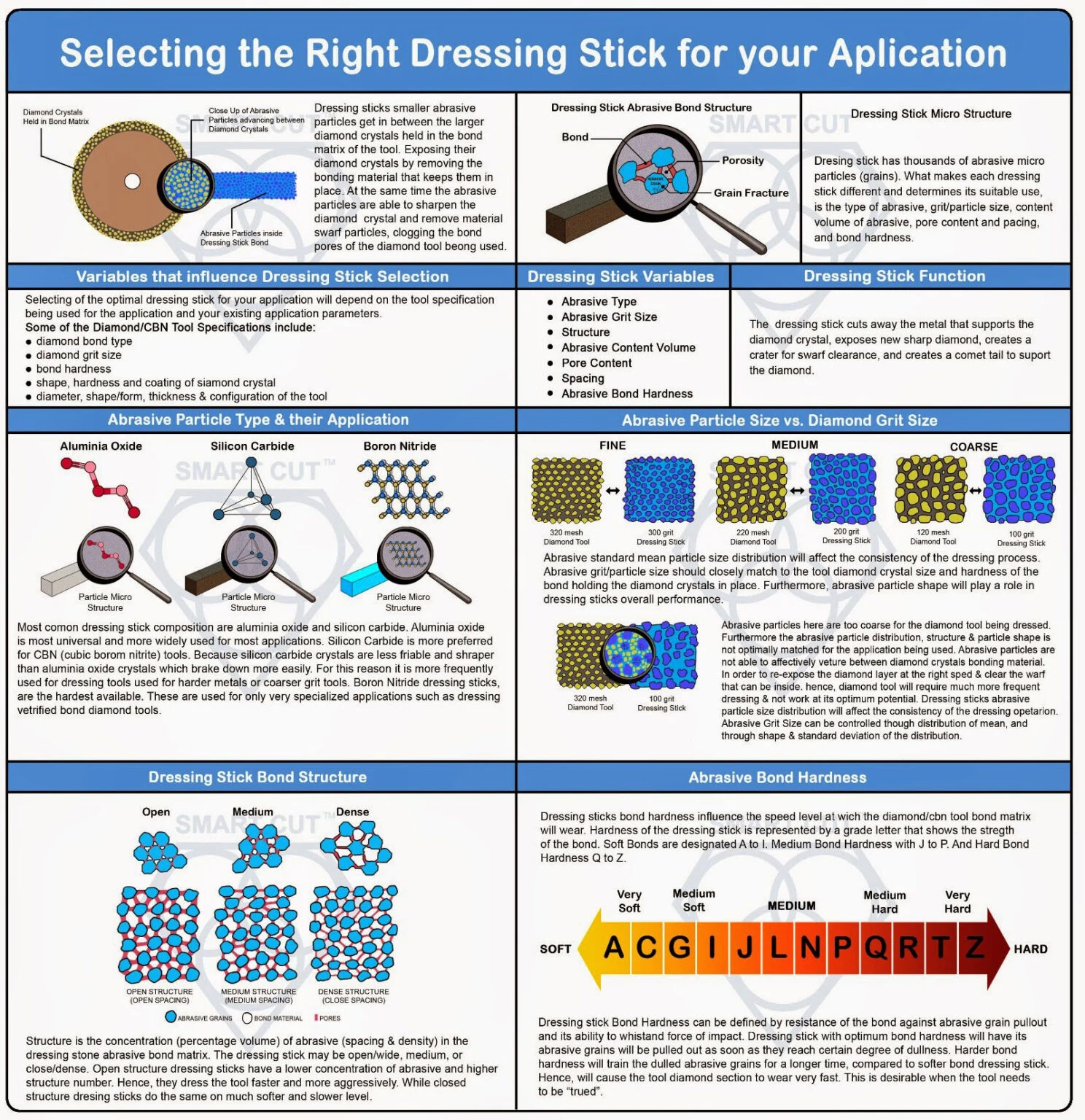
We recommend you give your new diamond tool the “Thumb Nail Test”. After thoroughly dressing the blade, you should be able to snag your thumb nail on the diamonds. This will let you know they are sticking up in order to cut properly. After using your diamond tool for a while, it may seem to cut more slowly or begin to chip your material. This is because the diamonds are not longer exposed. Find out more: Dressing Sticks
-
 “resistance” in cutting
“resistance” in cutting
-
 diamond tool is not cutting as easily
diamond tool is not cutting as easily
-
 diamond tool is lowing down
diamond tool is lowing down
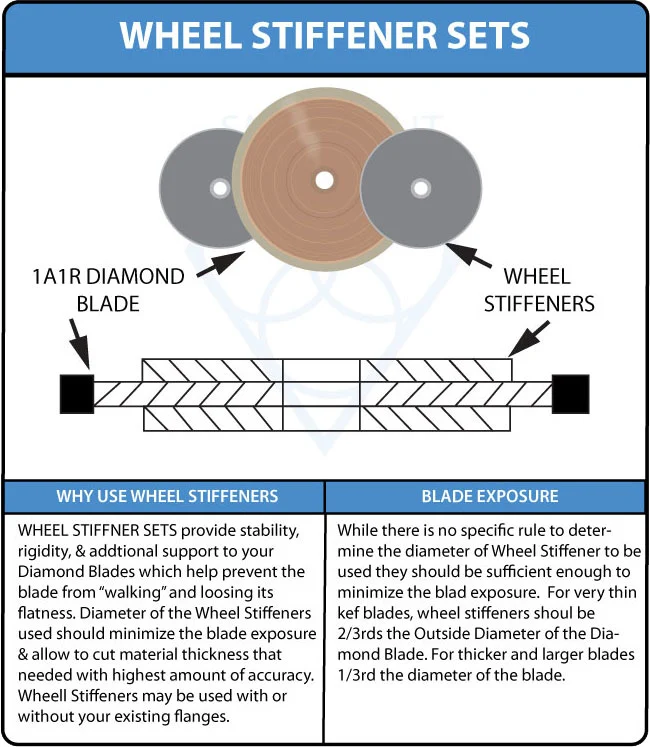
With some materials, you may find yourself using a very thin diamond blade to cut into the material. You may wish to avoid the “resistance” of a thicker blade, need to hold tight tolerances or you are cutting an expensive piece of material, where minimum loss is critical. Even though your cut may not be very deep, your machine may only accommodate a specific blade diameter. When your blade cuts into your material, it may not have the rigidity to maintain the tolerance. The blade may begin to walk. Although we use special alloy steel cores to minimize this problem. We suggest you insure maximum performance from your new diamond blade by using wheel stiffener sets to provide an extra degree of rigidity to the blade. Helping it run true. Wheel stiffener sets should be used at 2/3 rd’s the outside diameter of the Diamond blade and can be manufactured in all sizes needed. Find out more: Diamond Wheel Stiffeners
it is important to stop and dress the wheel again. Following the same procedure as before. This will restore the blade to it’s original condition. Depending on the material to be cut, this procedure will be need to be repeated. Without proper dressing, your blade will stop cutting. Hence breaking or shipping your material or tool. This is because you are no longer cutting with diamonds, but instead using metal bond to do the cutting.
USE THE RIGHT DIAMOND TOOL ACCESSORIES
To achieve optimum performance when using diamond core drills, water should be used down the center of the drill. We recommend that sealed bearing Drill Head Assembly (water swivel adapter) be used. Using a water swivel adapter helps your drills last up to 75% longer and minimizes material deformation and cracks associated with overheating.
We manufacture a large variety of water swivel adapter Models to accommodate different collets, chuck sizes, and thread sizes on the market. Water down the center of the drill also insures that the diamond section has a constant flow of coolant to keep maximum amount of diamonds exposed.


Alexander Schneider is a senior applications engineer and leading authority in the industrial diamond tooling industry, with over 35 years of hands-on experience in the development, application, and optimization of ultra-thin and high-precision diamond blades, diamond core drills, and diamond and CBN grinding wheels. His work spans a wide range of advanced materials including ceramics, glass, composites, semiconductors, and high-performance metals.
Throughout his career, he has collaborated with leading R&D institutions, national laboratories, and high-tech manufacturing companies across Europe, North America, and Asia, providing technical expertise and tailored solutions for demanding cutting and surface preparation applications.
Mr. Schneider has played a pivotal role in advancing precision cutting, sectioning, dicing, and grinding technologies used in research, production, and failure analysis. He is widely respected for his ability to optimize tool design and cutting parameters to meet exacting industry standards—balancing factors such as cut quality, blade life, material integrity, and process consistency.
As an author, Mr. Schneider is known for delivering practical, application-focused insights that translate complex technical challenges into clear, actionable strategies. His articles and technical guides serve as trusted resources for engineers, researchers, and manufacturers seeking to improve precision, reduce process variability, and enhance tool performance in critical applications.

ARE YOU USING RIGHT TOOLS
FOR YOUR APPLICATION?
LET US
HELP YOU
HAVING ISSUES WITH
YOUR CURRENT TOOLS?
Knowledge Center
Diamond Tool Coolants Why, How, When & Where to Use
Selecting the Right Coolant Method for your Diamond & CBN Tools
How to Selecting Right Diamond Tools for your application
How to properly use Diamond Tools
Why use diamond
Diamond vs CBN (cubic boron nitride) Tools
What is Diamond Mesh Size and how to select best one for your application
What is Diamond Concentration and which to use for your application
Choosing The Correct Diamond Bond Type

Alexander Schneider is a senior applications engineer and leading authority in the industrial diamond tooling industry, with over 35 years of hands-on experience in the development, application, and optimization of ultra-thin and high-precision diamond blades, diamond core drills, and diamond and CBN grinding wheels. His work spans a wide range of advanced materials including ceramics, glass, composites, semiconductors, and high-performance metals.
Throughout his career, he has collaborated with leading R&D institutions, national laboratories, and high-tech manufacturing companies across Europe, North America, and Asia, providing technical expertise and tailored solutions for demanding cutting and surface preparation applications.
Mr. Schneider has played a pivotal role in advancing precision cutting, sectioning, dicing, and grinding technologies used in research, production, and failure analysis. He is widely respected for his ability to optimize tool design and cutting parameters to meet exacting industry standards—balancing factors such as cut quality, blade life, material integrity, and process consistency.
As an author, Mr. Schneider is known for delivering practical, application-focused insights that translate complex technical challenges into clear, actionable strategies. His articles and technical guides serve as trusted resources for engineers, researchers, and manufacturers seeking to improve precision, reduce process variability, and enhance tool performance in critical applications.





















































